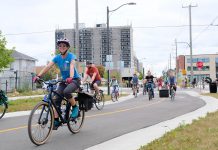
Walking and biking to school are great for children’s health, offer opportunities for quality time, and can even improve student concentration and performance.
Unfortunately, while most of today’s parents walked to school when they were kids, over the past several decades the number of families walking to school has steadily declined, and traffic congestion in school zones has become a daily reality.
In the 1980s, about 44 per cent of students in Canada used active transportation modes for the journey to school. Forty years later, it was down to 21 per cent according to Ontario Active School Travel’s research.
This decline in daily activity can seem like a casualty of modern life. The answers might seem obvious: we are busier, we have more commitments both at home and at work, and many of us live in more spread-out communities where walking to school seems out of reach. Let’s break down these ideas below and really get to the bottom of why less kids are walking to school.
The first issue is a hard one to change: are children living too far away from their schools? Not necessarily. For Peterborough elementary schools, on average over half of students live within their school’s walk zone, meaning distance cannot be the only reason people are not choosing an active trip to school.
Another often-cited reason is concerns about traffic danger. Parenting guides from the 1960s and 1970s suggest that kids as young as six were trusted to walk to school themselves, but recent brain development studies would suggest that, until about ages nine to 12, kids are unable to accurately judge the distance and speed of traffic.
Understandably, parents want to accompany and protect their children in busy school zones. However, these concerns can create a vicious cycle, where the perception that it is unsafe to walk to school leads parents to drive children, adding more vehicles and further decreasing safety.
VIDEO: “Why did Kids Stop Walking to School?”
Increased traffic in the school zone means more chances for injury, and risk is increased by both the volume and speed of vehicular traffic. Cars going at 50 kilometres per hour, for example, have a fatality rate of 80 per cent, whereas cars heading at 30 kilometres per hour have a fatality rate of only 10 per cent.
In addition, research shows that not all children or neighbourhoods face risk equally, and it is the children who don’t have the luxury of choice who are potentially being put in more danger.
Children of equity-deserving groups are more likely to walk or bike to school, and often do so in neighbourhoods where infrastructure like sidewalks and crossings are not prioritized. A report analysis by CBC noted that lower income neighbourhoods in Toronto have 50 per cent more fatal collisions between cars and pedestrian than more affluent neighbourhoods.
Equity issues within the walk to school are both structural and cultural. Although we cannot snap our fingers and have the layout or density of our cities change, or immediately lower all speed limits, we can shift in some tangible ways with key interventions that shift our culture, or change our own mindset.
Enter the walking school bus — a small solution that can yield wider social benefits.
It works similarly to a regular school bus, where students are “picked up” at predetermined times and locations. Walking together, parent or volunteer “drivers” lead the group safely to school.
Walking in a large group adds visibility and increases safety while also serving as a reminder that our streets and cities are for people, not just people in cars.

With a walking school bus, kids have fun and de-stress with their friends and arrive at school with clear heads, ready to learn. In a world where only 17.5 per cent of children get their daily recommended 60 minutes of exercise, this can improve mental, social, and physical health.
It can provide relief for busy parents, too, who no longer have to drive their kids into the busy and stressful school zone. This reduces traffic congestion and harmful emissions, contributing to a safer environment for all.
Walking school buses are a powerful tool in changing our cultural attitudes. It is no wonder that this trend has been gaining traction across social media platforms.
This initiative reminds us of the power of community, and that big change can come from simple solutions, even in our own neighbourhoods. Connect with friends, neighbours, or school councils to begin organizing a walking school bus today.
For more information on walking school buses, check out this online resource from The Canadian Cancer Society. If you have any concerns with your school walk zone, contact Active School Travel Peterborough at activeschooltravel@greenup.on.ca.
This article was inspired by filmmaker and urbanist Utaye Lee’s video on the topic (see above).



























